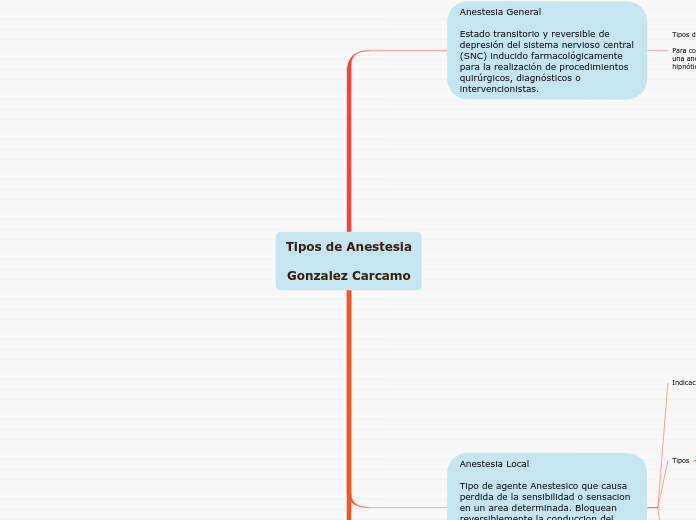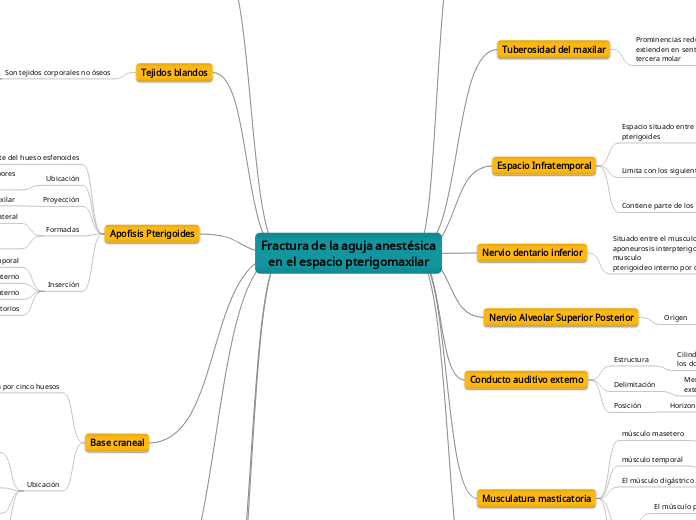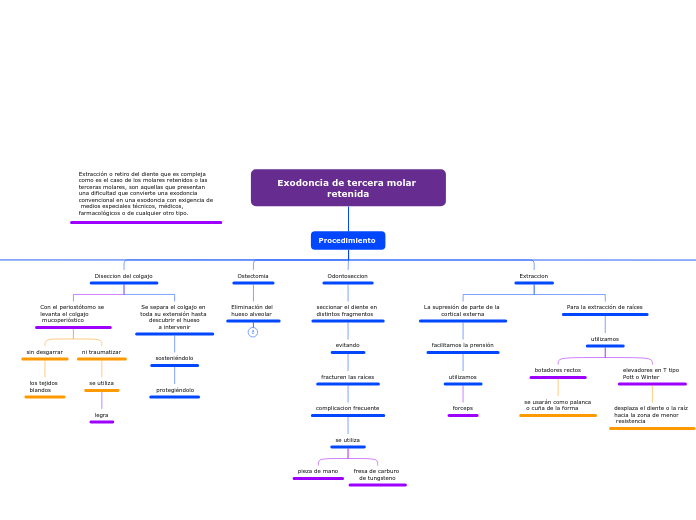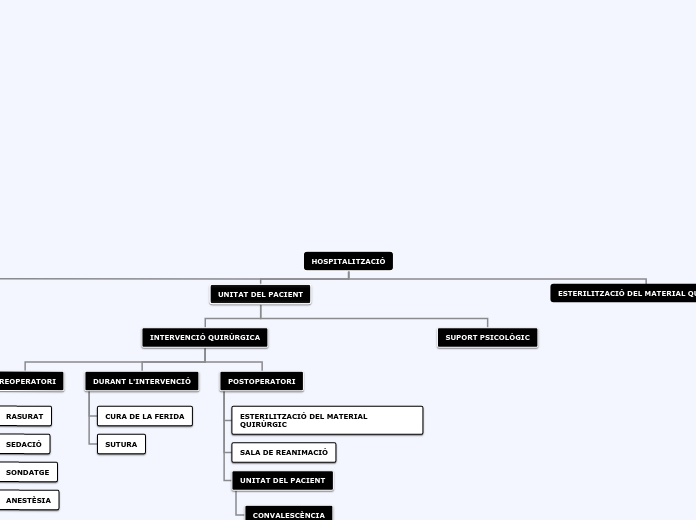Tipos de Anestesia
Gonzalez Carcamo
To name your story, you have to think about the overall message and what you want your audience to understand from the story. Also, make it relevant and easy to remember.
Anestesia Regional
Conjunto de técnicas anestésicas que producen una disminución reversible de la sensibilidad en un área concreta del cuerpo. Esto se consigue mediante el uso de anestésicos locales en la proximidad de la médula espinal (anestesia regional neuroaxial) o de troncos/nervios periféricos (bloqueos nerviosos).
The ending of a story is essential. We all know that if the ending is weak, what happened before loses its importance. So make it unpredictable, but fair. A resolved ending answers all the questions and ties up any loose threads from the plot.
Contraindicciones
This is the closure section of the story.
See examples of possible outcomes below:
- all problems have been solved
- it's clear how each one of your characters ends up
- your main character is transformed by the challenge
Hipersensibilidad
Try answering these questions to come up with a closure:
- Have all the problems been solved?
- Is there a clear picture of what happens with each character in the story?
- Has the challenge transformed your main character?
- How do the characters feel in the end?
This is the moment when the main character surpasses the last obstacle and finally faces their greatest challenge.
The climax usually follows one of these patterns:
- realization
- resolution
- choice
Type in your answer.
En intervenciones abdominales, de las extremidades inferiores, del sistema urinario y de la zona rectal, vaginal o perineal. Se tuliza para controlar el dolor despues del parto natural, durante y despues de un parto por cesare y dolor postoperatorio
Anestesia Local
Tipo de agente Anestesico que causa perdida de la sensibilidad o sensacion en un area determinada. Bloquean reversiblemente la conduccion del nervio, producen la perdida de la sensibilidad sin perdida de la conciencia
The middle of the story is where you add layers of complications that will lead to the end. Reveal more about the character's journey. Did their personality go through changes? How did they overcome the challenges? And as you build up the story’s central conflict, make it more personal to that character. Also, from the middle act, you have to lead into the final act.
Contraindicaciones
There wouldn't be any tension and excitement in your story if there weren't any obstacles in your character's way.
Sabor metalico
Hormigueo en boca y labios
Entumecimiento
Ansiedad
Retencion urinaria
Arritmias
Convulsiones
A story is nothing more than a character overcoming a series of difficulties to reach the desired goal. Obstacles usually create suspense and conflict. In overcoming obstacles, there is growth: weak becomes strong; hatred turns into love; sadness into happiness; wrong into right; lies into truth; or evil becomes good.
See a few examples below:
- stopping a meteor
- finding a killer
- finding love
Tipos
Your character(s) need(s) motivation in order to solve the challenge(s).
Espinal
La solucion anestesica se inyecta en el espacio subaracnoideo alrededor de la medula
Bloqueo nervioso
Secondary characters also might have motivs beacuse of which they may cross path with main character or which might trigger them to help the main character.
Se realiza mediante la inyeccion de la soluciom anestesica a traves del trayecto del nervio antes de que este alcance el tejido que se va a anestesiar
Regional
Secondary characters might also have motives that lead them to cross paths with the main character or which might trigger them to help the main character.
Cuando se requiere anestesia superficial como en sutura de heridas o infiltracion dental. Se inyectan pequeñas cantidades de la solucion anestesica en el tejido que rodea al sitio de operacion
Topica
Why does your character need to confront this challenge? What does he/she expect to accomplish by solving it?
See a few examples:
- will marry in 3 days
- can fix the mistakes of the past
Se aplica directamente el anestesico sobre la superficie de la piel, mucosa o en el ojo para prevenir o aliviar el dolor
Indicaciones
Each story has a main character and that character usually needs to solve a problem or challenge. The character's challenge is the one that creates tension throughout the story.
El farmaco se inyecta directamente dentro de los tejidos que el cirujano debe manipular
In most stories, there are 3 challenges. The number 3 is a mystical number symbolizing completeness. Try to come up with interesting challenges with which your character needs to struggle.
See a few examples below:
- turns into a werewolf at night
- is sent back in time
Anestesia General
Estado transitorio y reversible de depresión del sistema nervioso central (SNC) inducido farmacológicamente para la realización de procedimientos quirúrgicos, diagnósticos o intervencionistas.
In the beginning of the story (or the exposition), you will need to introduce the setting and characters. You might also want to introduce the main conflict. This part of the story is important because it gives the reader necessary background information and maybe even a first insight into a character’s personality.
Tipos de Anestesia General
Para conseguir el estado de inconsciencia propio de una anestesia general se administran fármacos hipnóticos, cuyo lugar de acción es el SNC
Characters are essential to a good story. Usually, the protagonist(s) is/are the most affected by the plot. Introduce a character by focusing on their actions, interests, and occupation, as the physical appearance doesn't make a difference in most cases.
Anestesia Balanceada
se utiliza la combinación de fármacos inhalados (efecto hipnótico) y fármacos intravenosos (opiáceos y relajantes musculares).
Es la técnica más utilizada hoy en día Suele realizarse la inducción con fármacos intravenosos (propofol, etomidato) y un mantenimiento inha latorio o intravenoso.
Anestesia Total Intravenosa (TIVA)
Se utilizan exclusivamente fármacos anestésicos intravenosos, junto con la mezcla de oxígeno y aire. Para conseguir una anestesia general se emplea una combinación de un hipnótico, un ana lgésico opiáceo y un relajante muscular (en caso de precisarse).
Entre sus inconvenientes están un mayor riesgo de despertar intraoperatorio si no se monitoriza la profundidad de la hipnosis y una menor sencillez de administración.
Algunas ventajas de la TIVA son:
Menor contam inación ambiental del quirófano.
Mayor seguridad en pacientes con antecedentes
de hipertermia mal igna
Mayor calidad del periodo postoperatorio
inmediato
Protección cerebral,
Menor alteración del reflejo de vasoconstricción pulmonar
hipóxica
Mayor seguridad en pacientes con antecedentes
de hipertermia maligna
Los fármacos más utilizados en la actualidad son:
Relajantes musculares
Succinilcolina
Cisatracurio
Rocuronio
Analgésicos opiáceos
Fentanilo
Remifentanilo
Hipnóticos
Ketamina
Midazolam
Tiopental
Etomidato
Propofol
Anestesia inhalatoria
Se realiza mediante la administración de uno o varios anestésicos inhalatorios en forma de gas o vapor mezclados con un gas vector que es el oxígeno, el aire o ambos; generalmente, sevoflurano, desflurano o isoflurano (derivados halogenados), a los que puede añadirse óxido nitroso.
Type in the name of your character.
El desf1urano produce potencialmente irritación de la VA, sobre todo en niños, por lo que no está recomendado para la inducción anestésica, aunque sí para el mantenimiento.
Sevoflurano, isoflurano y desflurano no están recomendados en caso de hipovolemia grave.
Add other properties of the character.
En el caso del óxido nitroso, está contra indicado en situaciones en las que haya cavidades no fisiológicas llenas de gas (Iaparoscopia, neumotórax, embolia gaseosa).
Add other qualities/attributes of the character.
Es una contraindicación absoluta para la inducción inhalatoria con halogenados la hipertermia maligna
What is your character's main goal?
fight Evilfind lovedefeat his/her enemyrule the worldmake friendstime travelmake an awesome discoveryOther
Otra indicación de la inducción inhalatoria son los pacientes con dificultad de intubación, ya que permite con mayor fac ilidad la pérd ida de consciencia con el mantenimiento de la respiración espontánea.
Which traits best describe the character's personality? Choose more if necessary:
introvertedloyalkindindependentquick-thinkingadventuresomeidealisticsweet-naturedcalmrisk-takercreativewittystrictfussyweirdclumsyharshaggressivecarelessclingingcowardlycrueldeceitfulimpulsiveOther
La inducción inhalatoria es fácil de administrar, rápida y segura, con posibilidad de canalizar la vía venosa periférica con el paciente inconsciente, por lo que es una técnica muy utilizada en anestesia pediátrica y en pacientes con discapacidad intelectual.
Choose the type of your chacter:
Protagonist (main character)Antagonist (main character's opponent)Flat (stereotypical character)Round (his/ her personality develops throughout the story)Static (doesn't evolve as a person throughout the story)Dynamic (dramatical change in personality)Confidant (the main character trusts him/ her)Foil (contrasting character who enhances the personality of another character)Other










